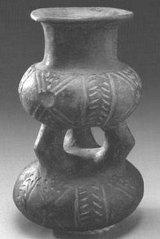
Mesoamerican chronology
Overview
Pre-Columbian
The pre-Columbian era incorporates all period subdivisions in the history and prehistory of the Americas before the appearance of significant European influences on the American continents, spanning the time of the original settlement in the Upper Paleolithic period to European colonization during...
Mesoamerica
Mesoamerica
Mesoamerica is a region and culture area in the Americas, extending approximately from central Mexico to Belize, Guatemala, El Salvador, Honduras, Nicaragua, and Costa Rica, within which a number of pre-Columbian societies flourished before the Spanish colonization of the Americas in the 15th and...
into several periods: the Paleo-Indian (first human habitation–3500 BCE), the Archaic (3500–2000), the Preclassic (2000 BCE–200 CE), the Classic (200 CE–1000CE), and the Postclassic (1000 CE–1697 CE). Some of the period divisions are taken from the history of the Maya
Maya civilization
The Maya is a Mesoamerican civilization, noted for the only known fully developed written language of the pre-Columbian Americas, as well as for its art, architecture, and mathematical and astronomical systems. Initially established during the Pre-Classic period The Maya is a Mesoamerican...
: The Preclassic-Classic boundary marks the first Maya "collapse", the Classic-Postclassic boundary marks the second, and the end date of 1697 marks the conquest of the last independent Maya city
Maya city
A Maya city was a centre of population of the pre-Columbian Maya civilization of Mesoamerica. It served the specialised roles of administration, commerce, manufacturing and religion that characterised ancient cities worldwide...
-state, Tayasal
Tayasal
Tayasal is a pre-Columbian Maya archaeological site that dates to the Postclassic period. The site is located in the southern Maya lowlands on a small island in Lake Petén Itzá, now part of the Department of Petén in northern Guatemala...
.

